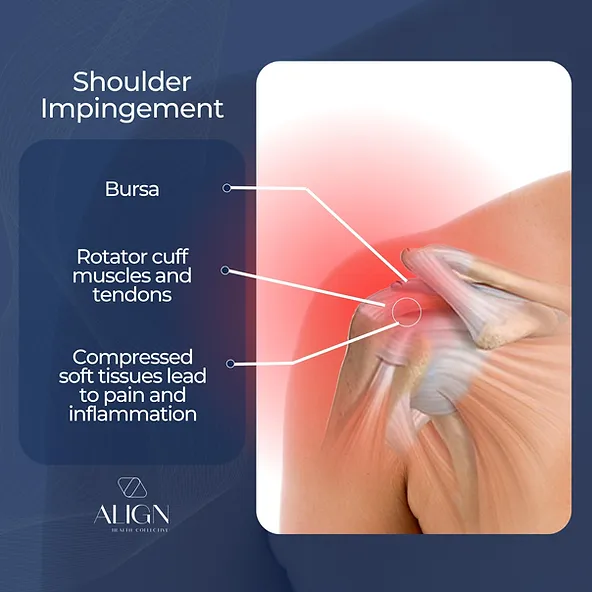Are you experiencing shoulder pain? Does the pain get worse when you reach overhead or when you sleep or lie on your shoulder? If so, you could have shoulder impingement syndrome.
Shoulder impingement is a very common cause of shoulder pain. It occurs when the tendons, muscles, or bursa in the shoulder joint are compressed, which leads to pain and inflammation. Shoulder impingement is also called “swimmer’s shoulder” or “tennis shoulder”.
If you are experiencing any shoulder pain, you should consult a healthcare professional as soon as you can. Shoulder impingement can get worse over time, and can lead to torn tendons, a tear in your rotator cuff, shoulder bursitis (inflamed bursa), or rotator cuff tendinitis. Align Health Collective in Melbourne, Victoria, offers a range of physiotherapy and non-surgical treatments for shoulder impingement to help improve your shoulder function and reduce your pain.
In this article, we’ll cover the causes, symptoms, treatment plans, and preventative techniques for shoulder impingement, as well as the expertise and tailor-made services you can expect from our physiotherapy clinics in Melbourne.

What is Shoulder Impingement?
Shoulder impingement occurs when the rotator cuff muscles and tendons, the bursa, and the surrounding shoulder bones rub or knock against one another. Shoulder impingement happens because there isn’t enough space around these structures, or if they are used repetitively, you will experience shoulder pain and inflammation.
It’s important to note that the delicate structures making up the ball and socket joint in our shoulders will go through normal wear and tear throughout our lives; however, age, overuse, and previous shoulder injuries or trauma can increase the friction between these structures, resulting in shoulder impingement.
Causes and Symptoms of Shoulder Impingement
Causes
Shoulder impingement can be caused by a wide range of factors, including injuries, overuse, and degenerative conditions.
- Repetitive overhead arm movements, such as those used in swimming, tennis, rugby, painting, (un)packing high shelves, regular heavy lifting
- Poor posture
- Shoulder instability
- Trauma or injury to the shoulder
- Bone spurs or abnormal bone growth
- Aging and natural degeneration of the shoulder joint.
Symptoms
Shoulder impingement can cause numerous symptoms, each of which can vary in severity and level of pain.
- Pain in the shoulder area, especially when lifting your arm overhead or behind your back
- Weakness or loss of strength in the affected shoulder
- Difficulty reaching or lifting objects with the affected arm
- Shoulder stiffness
- Decreased or limited range of motion
- Tenderness or swelling in the shoulder area
- Clicking or popping sensations in the shoulder joint.
As shoulder impingement can lead to torn tendons of the shoulder joint and other incredibly painful conditions, if you have any of the above symptoms, you should seek help and advice from a qualified healthcare professional.
Diagnosis
During your consultation, your physiotherapist will begin by conducting a physical exam of your shoulder to check for tenderness, swelling, bruising, and range of motion. You will likely be asked to move your shoulder in specific ways and describe the pain associated with those movements.
Your physiotherapist may also refer you to an orthopaedic surgeon or recommend diagnostic tests such as an ultrasound, X-ray, or MRI. Diagnostic tests will assist in assessing the extent and nature of your shoulder impingement.
These tests will also be able to rule out other common shoulder conditions that could be causing your pain, such as subacromial bursitis, tendonitis, arthritis, calcific deposits, or bone spurs.
Treatment Options for Shoulder Impingement
There are various non-surgical and surgical options available for treating shoulder impingement. Let’s have a look at some of the common treatments.
Non-Surgical Treatments
Non-surgical treatments are usually the first treatment option for shoulder impingement. These may include:
- Physiotherapy – including exercises to strengthen the rotator cuff muscles and improve range of motion
- Manual therapy to release tight muscles and improve shoulder joint mobility
- Ultrasound therapy to promote healing and reduce inflammation
- Anti-inflammatory medications
- Steroid (cortisone) injections
- Rest and ice therapy.
Arthroscopic Surgery
If non-surgical treatments do not provide pain relief, your physiotherapist may recommend arthroscopic surgery. This is a minimally invasive procedure which involves making small incisions in the shoulder.
Then, using a camera and small instruments, your surgeon will remove any bone spurs, inflamed tissue, calcium deposits, or damaged tendons. Arthroscopic surgery is typically an outpatient procedure, while recovery is faster than open surgery.
Open Surgery
Open surgery may be required for severe shoulder impingement. Open surgery may be necessary if there is significant damage to the rotator cuff tendons, or if bone spurs are too large to be removed with arthroscopic surgery.
Open surgery involves making a larger incision in the shoulder and removing the damaged tissue or bone spurs. Recovery time for open surgery is typically longer than for arthroscopic surgery.
Physical Therapy to Reduce Pain and Improve Function
- Rotator cuff strengthening exercises: Internal and external rotation exercises, scapular stabilisation exercises, and wall push-ups
- Range of motion exercises: Shoulder circles, pendulum exercises, and shoulder stretches
- Posture correction exercises: Chest stretches, shoulder blade squeezes, and chin tucks
- Therapeutic ultrasound: This form of physical therapy uses high-frequency sound waves to promote healing and reduce inflammation. This treatment is often used in conjunction with other physical therapy exercises to improve outcomes.
Prevention Techniques and At-Home Remedies for Managing Symptoms
While physical therapy exercises and other non-surgical treatments can help manage shoulder impingement symptoms, there are also several prevention techniques and at-home remedies that you can use to reduce pain and prevent future injury.
- Rest and ice: Rest the affected shoulder and apply ice to reduce inflammation. Applying ice for 15–20 minutes every few hours can help reduce pain and swelling.
- Improve posture: Poor posture places additional stress on the shoulder joint, so improving your posture can help reduce pain and prevent future injury. Try to keep your shoulders back and down, and avoid slouching or hunching forward.
- Modify activities: Modify any activity that requires repetitive overhead arm movements, such as throwing sports or weightlifting. Taking frequent breaks can also help to reduce stress on the shoulder joint.
- Strengthen shoulder muscles: Incorporate shoulder strengthening exercises into your daily routine, such as shoulder blade squeezes, wall push-ups, and rotator cuff strengthening exercises.
- Anti-inflammatory diet: Add anti-inflammatory foods, such as fruits, vegetables, and Omega 3 fatty acids to your diet. You should also avoid food that aggravates inflammation, such as sugar, processed foods, saturated fats, and any items made with white flour.
Get in Touch
At Align Health Collective in Melbourne, VIC, we understand that living with shoulder impingement can be a painful and challenging experience, which is why we are dedicated to providing our patients with the highest level of care and support throughout the consultation and diagnosis process.
We offer a range of effective treatment options for shoulder impingement, including manual therapy, exercise therapy, and education on proper posture and movement techniques. We also offer advice on home remedies and prevention techniques to help you manage symptoms and prevent future injury.
All of our treatment plans are personalised and tailor-made for your individual requirements. Contact us today to schedule a consultation and take the first step towards healing.
FAQs
Which doctors treat shoulder impingement?
Doctors who specialise in sports medicine or orthopaedics are usually the best choice for diagnosing and treating shoulder impingement. It’s important to find a doctor who has experience treating shoulder injuries and can develop a personalised treatment plan for you.
Can shoulder impingement be cured completely?
With the proper treatment, shoulder impingement can be fully resolved. However, the recovery time will vary depending on the severity of the injury and the individual’s overall health. Follow your doctor or physiotherapist’s treatment plan to ensure the best possible outcome.
Is shoulder impingement surgery worth it?
Shoulder impingement can often be successfully treated with non-surgical methods such as physiotherapy. However, if non-surgical treatments are not effective or the impingement is severe, surgery may be recommended. The decision to undergo surgery should be made in consultation with your doctor or surgeon.
Can I lift weights with shoulder impingement?
It depends on the severity of your shoulder impingement and the specific exercises you want to do. Any exercises that involve overhead arm movements may need to be avoided, modified, or performed with lighter weights to prevent further injury. Consult your physiotherapist or doctor before beginning any weightlifting programme.
